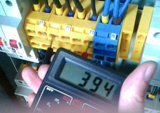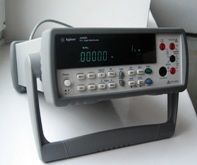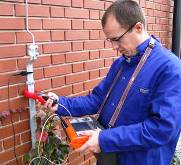Types and methods of electrical measurements

When studying electrical engineering, one must deal with and measure electrical, magnetic, and mechanical quantities.
To measure an electrical, magnetic, or other quantity is to compare it with another homogeneous quantity taken as a unit.
This article discusses the most important measurement classification for theory and practice of electrical measurements… This classification may include the classification of measurements from a methodological point of view, i.e. depending on the general methods of obtaining the measurement results (types or classes of measurements), the classification of measurements depending on the use of principles and measuring devices (methods of measurement) and the classification of measurements depending on the dynamics of the measured values.
Types of electrical measurements
Depending on the general methods of obtaining the result, measurements are divided into the following types: direct, indirect and joint.
For direct measurements include those whose result is obtained directly from experimental data.Direct measurement can be conventionally expressed by the formula Y = X, where Y is the desired value of the measured value; X — value obtained directly from experimental data. This type of measurement involves measurements of various physical quantities using instruments calibrated in established units.
For example, measurements of current with an ammeter, temperature with a thermometer, etc. This type of measurement also includes measurements where the desired value of a quantity is determined by direct comparison with a measure. The means used and the simplicity (or complexity) of the experiment are not taken into account when attributing a straight line measurement.
Indirect is called such measurement, in which the desired value of the quantity is found on the basis of the known relationship between this quantity and the quantities subjected to direct measurements. For indirect measurements, the numerical value of the measured value is determined by calculating the formula Y = F (Xl, X2 ... Xn), where Y — the required value of the measured value; NS1, X2, Xn — the values of the measured quantities. An example of indirect measurements is the measurement of power in DC circuits with an ammeter and a voltmeter.
Joint measurements are called those for which the required values of different quantities are determined by solving the system of equations connecting the values of the required quantities with the directly measured quantities. As an example of joint measurements, the definition of the coefficients in the formula relating to the resistance resistor with its temperature can be given: Rt = R20 [1 + α (T1-20) + β (T1-20)]
Electrical measurement methods

The essence of the direct assessment method consists in the fact that the value of the measured quantity is estimated from the readings of one (direct measurements) or several (indirect measurements) devices, pre-calibrated in units of the measured quantity or in units of other quantities on which the measured magnitude quantity depends.
The simplest example of a direct estimation method is the measurement of each quantity with a device whose scale is graduated in the appropriate units.
The second large group of electrical measurement methods is combined under the general name comparison methods... They include all those electrical measurement methods in which the measured value is compared with the value reproduced by the measure. Thus, a distinctive feature of comparison methods is the direct involvement of measures in the measurement process.
Comparison methods are divided into the following: null, differential, substitution and matching.
Null method This is a method of comparing a measured value with a measure in which the result of the influence of the values on the measure is reduced to zero. Thus, when equilibrium is reached, a certain phenomenon disappears, for example, the current in a section of a circuit or the voltage across it, which can be recorded with the help of devices serving this purpose. — zero indicators. Due to the high sensitivity of the zero indicators, and also because the measurements can be carried out with great accuracy, a high measurement accuracy is also obtained.
An example of an application of the null method would be the measurement of electrical resistance through a fully balanced bridge.
In the differential method, as in the null method, the measured value is compared directly or indirectly with the measure, and the value of the measured value as a result of the comparison is judged by the difference between the effects simultaneously produced by these values and the known value reproduced by the measure. Thus, with the differential method, an incomplete balancing of the measured value is obtained, and this is the difference between the differential method and zero.
The differential method combines some of the characteristics of the direct estimation method and some of the characteristics of the null method. It can give a very accurate measurement result only if the measured value and the measure are slightly different from each other.
For example, if the difference between these two quantities is 1% and is measured with an error of up to 1%, then the measurement error of the desired quantity is thus reduced to 0.01% if measurement errors are not taken into account. An example of the application of the differential method is the measurement of the difference between two voltages with a voltmeter, one of which is known with high accuracy and the other is the desired value.

An example of applying the method of substitution would be the measurement of a relatively large DC electrical resistance by successively measuring the current flowing through the controlled resistor and the sample. The circuit must be powered by the same current source during the measurements. The resistance of the current source and the device that measures the current must be very small compared to the variable and sample resistances.
Matching method This is a method in which the difference between the measured value and the value reproduced from the measurement is measured using the matching of the scale mark or periodic signals. This method is widely used in the practice of non-electrical measurements.
An example of this is measuring length vernier caliper… In electrical measurements, an example is the measurement of body velocity with a stroboscope.
We will also indicate a classification of measurements based on the change over time of the measured value... Depending on whether the measured value changes over time or remains unchanged during the measurement process, a distinction is made between static and dynamic measurements. Statically refers to measurements of constant or stationary values.These include measurements of the rms and amplitude values of quantities, but in steady state.
If instantaneous values of time-varying quantities are measured, then the measurements are called dynamic... If during dynamic measurements the measuring instruments allow you to continuously observe the values of the measured quantity, such measurements are called continuous.
It is possible to make measurements of any quantity by measuring its values at some time points t1, t2, etc. As a result, not all values of the measured quantity will be known, but only the values at the selected times. Such measurements are called separate.
